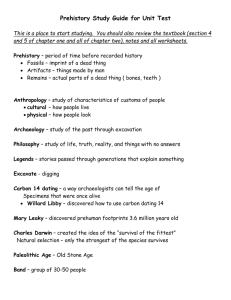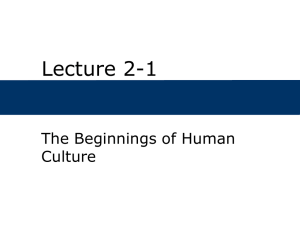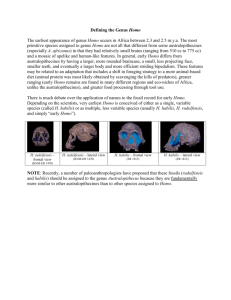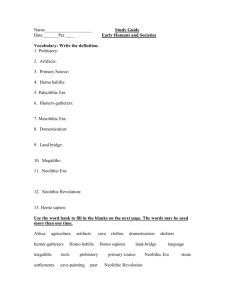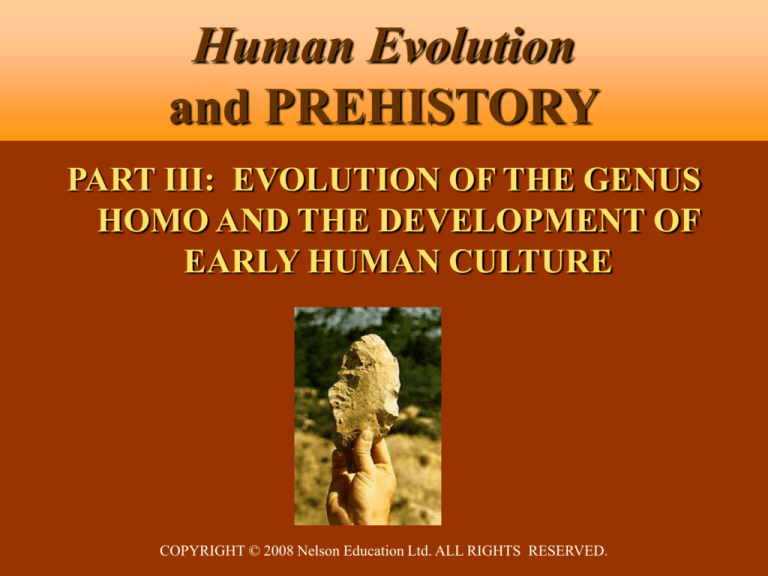
Human Evolution
and PREHISTORY
PART III: EVOLUTION OF THE GENUS
HOMO AND THE DEVELOPMENT OF
EARLY HUMAN CULTURE
COPYRIGHT © 2008 Nelson Education Ltd. ALL RIGHTS RESERVED.
Human Evolution
and PREHISTORY
Chapter Seven:
HOMO HABILIS AND
CULTURAL ORIGINS
Link to the Canadian Association for Physical Anthropology
COPYRIGHT © 2008 Nelson Education Ltd. ALL RIGHTS RESERVED.
Chapter Preview
When, Where, And How Did Human Culture
Develop?
When Did Reorganization And Expansion Of The
Human Brain Begin?
Why Did The Eating Of More Meat Lead To Improved
Brains?
COPYRIGHT © 2008 Nelson Education Ltd. ALL RIGHTS RESERVED.
EARLY REPRESENTATIVES OF THE
GENUS HOMO
Olduvai Homo habilis, 1.8 my
•
650-690 cc cranial capacity
•
Modern-looking hands, feet
•
Little difference from Australopithecus in body size,
sexual dimorphism, and tree-climbing abilities
•
Maturation rate closer to apes
•
Associated with stone tools
COPYRIGHT © 2008 Nelson Education Ltd. ALL RIGHTS RESERVED.
EARLY REPRESENTATIVES OF THE
GENUS HOMO
KNM ER 1470, Lake Turkana, 1.9 my
752 cc cranial capacity
Cranium is more modern in appearance than in
Australopithecus
Associated with stone tools
COPYRIGHT © 2008 Nelson Education Ltd. ALL RIGHTS RESERVED.
EARLY REPRESENTATIVES OF THE
GENUS HOMO
KNM ER 1470, Lake Turkana, 1.9 my
Inside of the skull shows a pattern in the left cerebral
hemisphere that is associated with the speech area and
right hand control of living humans
Wear patterns on tools indicate predominance of righthandedness
Brain was reorganized along human lines
COPYRIGHT © 2008 Nelson Education Ltd. ALL RIGHTS RESERVED.
Relations between Homo
habilis and Australopithecus
There is no agreement on what distinguishes
Australopithecus from Homo
One approach is to use the following characteristics:
Absolute brain size greater than 600 cc
Use of language and tools
Precision grip distinct to Homo
COPYRIGHT © 2008 Nelson Education Ltd. ALL RIGHTS RESERVED.
Relations between Homo
habilis and Australopithecus
Collard and Wood would define Homo by its adaptive
zone
Australopithecus
Body mass and shape more suited to closed
environments, e.g. forest
Ape-like diet
Ape-like development pattern
Combined locomotion of bipedalism and climbing
COPYRIGHT © 2008 Nelson Education Ltd. ALL RIGHTS RESERVED.
Relations between Homo
habilis and Australopithecus
Collard and Wood would define Homo by its
adaptive zone
Homo
Body mass and shape more like ours, suited to
open habitats
Diet more like ours
human-like development pattern
bipedalism
COPYRIGHT © 2008 Nelson Education Ltd. ALL RIGHTS RESERVED.
Relations between Homo
habilis and Australopithecus
Marked increase in brain/body size ratio
Heat-exchange system to keep brain cool (only a rudimentary
one in late gracile Australopithecines)
Smaller teeth in relation to skull size
Major brain-size increase and tooth-size reduction are
important trends in the evolution of the genus Homo
Earliest fossils to exhibit these features appear by 2.4 mya
(Baringo)
COPYRIGHT © 2008 Nelson Education Ltd. ALL RIGHTS RESERVED.
Relations between Homo
habilis and Australopithecus
None of the robust Australopithecines belong in the direct
human lineage; they coexisted with Homo habilis from 2.5 to
1 mya, headed in two very different evolutionary directions
The body of Homo habilis had changed little from gracile
Australopithecines; hence, they are likely suitable ancestors
for Homo
Did Australopithecus afarensis or Australopithecus africanus
give rise to Homo habilis?
Or was it Kenyanthropus (Chapter 6), to the exclusion of all
Australopithecines (minority view)?
COPYRIGHT © 2008 Nelson Education Ltd. ALL RIGHTS RESERVED.
Relations between Homo
habilis and Australopithecus
Most see early East African graciles as generalized
enough to have given rise to both Homo habilis and
robust Australopithecus
Homo habilis and robust australopithecines appear
about the same time in the fossil record
At least a 3-way split was underway by 2.5 mya (see
Figures 7.5 and 7.6 on next slides and in text)
COPYRIGHT © 2008 Nelson Education Ltd. ALL RIGHTS RESERVED.
Relations between Homo
habilis and Australopithecus
COPYRIGHT © 2008 Nelson Education Ltd. ALL RIGHTS RESERVED.
Relations between Homo
habilis and Australopithecus
COPYRIGHT © 2008 Nelson Education Ltd. ALL RIGHTS RESERVED.
LOWER PALEOLITHIC
TOOLS
The beginning of the “Old Stone Age” is marked
by the appearance of tools 2.6 million years old
COPYRIGHT © 2008 Nelson Education Ltd. ALL RIGHTS RESERVED.
Olduvai Gorge
2 million years ago Olduvai was a lake, whose shores were
inhabited by robust Australopithecines, Homo habilis and
later Homo erectus (chapter 8)
Assemblages of stone tools (2 mya) were found, associated
with bones of now-extinct animals and with evidence of
butchering
On an occupation surface, 1.8 mya, there was a “stockpile” of
basalt stones, forming a circle
COPYRIGHT © 2008 Nelson Education Ltd. ALL RIGHTS RESERVED.
Oldowan Tool Tradition
Flakes were struck from a stone
either by using a hammerstone, or
by striking the stone against a
large rock (anvil), using the direct
percussion method
It produced tools with sharp
edges, effective for cutting and
scraping
Microscopic wear patterns show
tool use for cutting meat, grasses,
wood
COPYRIGHT © 2008 Nelson Education Ltd. ALL RIGHTS RESERVED.
Oldowan Tools
Important technological advance for early hominins
Saving of labour and time
Addition of meat to diet on a frequent basis
Since dentition of Australopithecus and Homo is
poorly suited for meat eating (e.g. small canines),
sharp tools for butchering were needed
COPYRIGHT © 2008 Nelson Education Ltd. ALL RIGHTS RESERVED.
Tool Use
Probably a result of adaptation to an
environment changing from forests to
grasslands, 3-2 mya (see Figure 6.11)
COPYRIGHT © 2008 Nelson Education Ltd. ALL RIGHTS RESERVED.
Oldowan Tools and Bone Assemblages
H. habilis and large carnivores were active at the same
locations, based on combinations of toolmarks and gnaw
marks
Whole carcasses of animal skeletons are not represented
Tools were made of materials that were procured at a
distance
There was repeated use of sites over periods of 5-15 years
Suggesting that our Oldowan forebears were
SCAVENGERS
COPYRIGHT © 2008 Nelson Education Ltd. ALL RIGHTS RESERVED.
Tools, Meat, and Brains
After 2.5 mya meat became an important part
of the hominin diet
Early hominins lacked size and strength to
compete for kills and to drive off predators, so
must have relied on wit and cunning
COPYRIGHT © 2008 Nelson Education Ltd. ALL RIGHTS RESERVED.
ORIGINAL STUDY
Cat in the Human Cradle
An anatomical analysis has suggested that both Homo habilis
and A. afarensisi were better than us at climbing trees and
suspending
Archaeological evidence from South Africa and observation of
modern-day leopard activity support “tree-caching” as an
ancient form of leopard behaviour in Africa
The collection of bones at Olduvai Gorge then could be
explained by both ground scavenging and the scavenging of
leopard “tree kills” by Homo habilis
COPYRIGHT © 2008 Nelson Education Ltd. ALL RIGHTS RESERVED.
“Man the Hunter”
In the 1960s and 1970s the “man the hunter” model for
provisioning of the social group was supported, followed later
by documenting the role of “woman the gatherer”
Cooperation in food procurement and division of labour by
sex are seen as prime factors in the success of early Homo in
this model
Since these factors relate to male-female differences in the
distant past, they are generally attributed to biologically
determined sex differences rather than gender
COPYRIGHT © 2008 Nelson Education Ltd. ALL RIGHTS RESERVED.
Tools, Meat, and Brains
Behavioural reconstructions from fragments of bone
and stone rely on observations of living primates,
human (e.g. modern food foragers) and nonhuman
It is likely that the culture of Homo habilis played a
role in food-sharing behaviours, rather than strict
biological male-female differences
COPYRIGHT © 2008 Nelson Education Ltd. ALL RIGHTS RESERVED.
Hominid Brain and Meat Consumption
Increase in brain size correlates with appearance of
meat in the hominin diet
The human brain consumes more than twice the
energy of the brains of nonhuman primates
Meat is more energy-dense than plant food,
important for the evolving brain
COPYRIGHT © 2008 Nelson Education Ltd. ALL RIGHTS RESERVED.
Hominid Brain and Meat Consumption
The most readily accessible plant sources were leaves and
legumes, difficult for primates to digest
Chimps search for animal foods on the savanna; why not our
ancestors, too?
Increased meat consumption ensured an adequate intake of
essential amino acids and more leisure time for exploring the
environment
These factors may have stimulated brain development, as
indicated by significant increase in brain size in Homo habilis
COPYRIGHT © 2008 Nelson Education Ltd. ALL RIGHTS RESERVED.
THE EARLIEST SIGNS OF
CULTURE AND TOOLS
1. Problem solving, e.g. the use of stone tools to
butcher and prepare meat
2. Tool manufacture, emphasizing manual
dexterity and fine manipulation, resulting in
improved organization of the nervous system
3. Abstract idea of the tool, plus the steps and
materials to make it
COPYRIGHT © 2008 Nelson Education Ltd. ALL RIGHTS RESERVED.
Language Origins
Importance of cooperation, planning and foresight for H. habilis
raises questions about communication abilities
Humans and apes share a gesture-call system, inherited from
the common ancestor
Humans and apes share language potential (apes to the level of a
2-3 year-old)
These shared abilities must have been possessed by the earliest
hominins as well
COPYRIGHT © 2008 Nelson Education Ltd. ALL RIGHTS RESERVED.
Language and the Homo habilis Brain
The speech area is adjacent to that involved in precise hand
control
Manufacture of Oldowan tools require manual skills beyond
those of chimpanzees using stones and anvils for nutcracking (chapter 4)
H. habilis exhibited handedness in toolmaking which is
associate with lateralization of the brain
Lateralization is associated with language
COPYRIGHT © 2008 Nelson Education Ltd. ALL RIGHTS RESERVED.
NEXT TIME:
Homo erectus and the Emergence of
Hunting and Gathering
COPYRIGHT © 2007 Nelson, a division of Thomson Canada Limited. ALL RIGHTS RESERVED.

